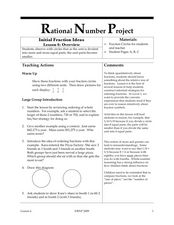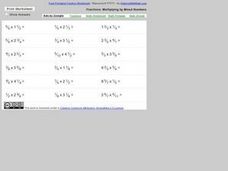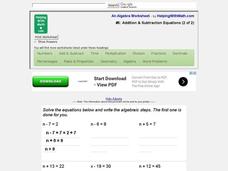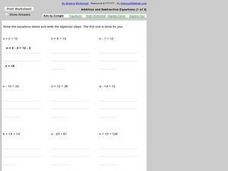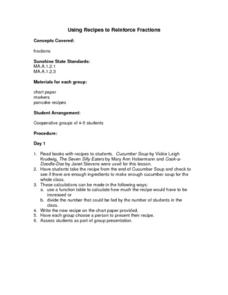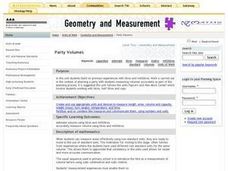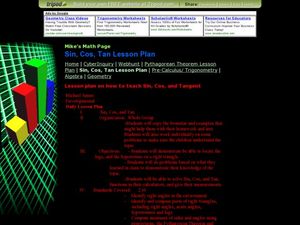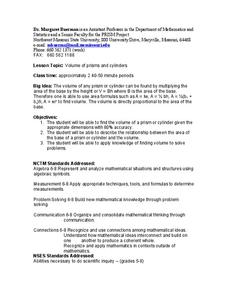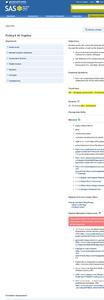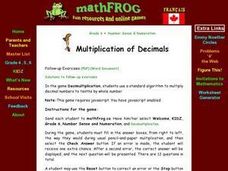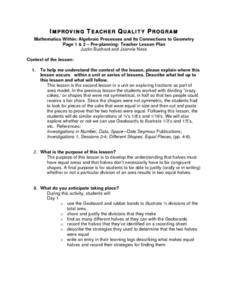Curated OER
Pizza Fractions
Students investigate relationships among fractions and use cut out pizzas and fraction circles to compare equivalent fractions. They exchange fractional parts of construction paper pizza circles to use as many different fractional parts...
Curated OER
Folded Fractions
Second graders, in pairs, use various geometric shapes to represent fractional parts and divide them into equal parts.
Curated OER
Fractions in Clay
Students represent and explain fractions as part of a set using modeling clay. They create sets of objects as specified by individual task cards.
Curated OER
Initial Fraction Ideas Lesson 6: Overview
Students use fraction circles to observe fractions in smaller parts and to complete charting and word problem activities. In this fraction lesson plan, students complete chart problems, word problems, and fraction comparing problems...
Curated OER
Fractions: Multiplying by Mixed Numbers
In this math activity, students solve 30 problems in which a fraction and a mixed number are multiplied. Examples are written horizontally on the page.
Helping with Math
Solving Equations with Two-Stepping! (2 of 4)
Multi-step problems are part of the progression when learning to solve equations. These 12 problems require only two steps to arrive at an answer. Either print the page out to assign as homework, or have learners write down the problems...
Curated OER
Pythagorean Theorem
Students solve problems using the Pythagorean Theorem. In this geometry instructional activity, students identify different parts of a right triangle. They use the Pythagorean Theorem to calculate missing angles and sides.
Helping with Math
#6: Addition and Subtraction Equations (2 of 2)
This printable contains 12 basic equations to be solved. The first one is worked out as an example, and the answers for all can be found by clicking on a "Show Answers" box found on the website. The publisher has identified this as...
Helping with Math
#5: Addition & Subtraction Equations (1 of 2)
Single-step addition or subtraction operations are applied in order to solve these 12 simple equations. An answer key is available, not so much for you, but perhaps to be used by learners as a self-correction tool. Note that the...
Curated OER
Percentages
In this Algebra I worksheet, 9th graders solve percent problems in which they are given the part and the whole and find the missing percentage. The one page interactive worksheet contains ten problems. Answers and a hint are...
Curated OER
Using Recipes To Reinforce Fractions
Students calculate fractions used in various food recipes in this Math lesson with real world applications. The lesson is geared towards upper elementary students but can be adapted for various levels of learners. State math standards...
Curated OER
Party Volumes: Measurement
Second graders explore liters and milliliters. They estimate volume and accurately measure the volume. Students plan a party and measure volume using liters and milliliters as part of the planning process.
Curated OER
Sin, Cos and Tangent
Students find the identity o sine, cosine and tangent. In this precalculus lesson, students solve and identify the different parts of a right triangle. They use the ratios of the Pythagorean Theorem to find the missing side or angle.
Curated OER
Volumes of Prisms and Cylinders
Students calculate the volume of prisms and cylinders. In this geometry lesson, students are give part of the formula, and must calculate the missing parts. They use 80% accuracy for their dimensions.
Curated OER
Putting It All Together
Learners complete activities to learn about the shapes and their vertices. In this shape recognition lesson, students discover the rule linking the number of sides with the number of vertices for shapes. Learners categorize...
Curated OER
Average and Percentages - Week 2
In this average and percent learning exercise, students solve percentage problems by using proportions. These story problems include sequences, percent of change and cost. This two-page learning exercise contains seven problems.
Helping with Math
Identifying and Writing Decimals up to Tenths
When beginning to teach you math class how to write decimals, this assignment will support the first step. On it, learners examine sets of blocks that include wholes and tenths, and then the write the value of the number. Use this as an...
Curated OER
Integrating Mathematics Into Literature
Students discuss tables, multiples, fractions, ratios, and probability while participating in daily activities in this cross-curricular Math lesson using examples from Literature. State standards in Mathematics are addressed over the...
Curated OER
Telling Time to 5 Minutes
Students take part in various activities ranging from creating a human clock, to small group problem solving to reinforce the concept of telling time accurately to five minutes on an analog clock.
Curated OER
Multiplication of Decimals
Students participate in a lesson that explores the concept of using multiplication with decimals. They practice using the operation using whole numbers and progress to the use of decimals. The lesson includes dialogue for the teacher to...
Curated OER
Fractions and Halves
Fourth graders examine halves of a whole and discover through activities that they must be exactly equal in size. Working with Geoboards and Dot-Paper Squares, the class practices finding halves that are both congruent and incongruent.
Helping with Math
Identifying and Writing Decimals up to Thousandths
A simple worksheet asks learners to write five numbers in decimal form. Sets of blocks represent the numbers and include whole number blocks, tenths, hundredths, and thousandths. Use this to follow other worksheets by the same publisher...
Curated OER
Raising Resources
Students determine how much it will cost to participate in a service project. In this service project lesson, students develop a budget for participating in a service project while looking at the cost of the whole project. They make a...
Curated OER
Geometers Sketchpad Practice
Students create polygons using geometers sketchpad. In this geometry lesson, students construct the interior angles of polygons and label the different points. They estimate and measure the different parts as they draw conclusion.



